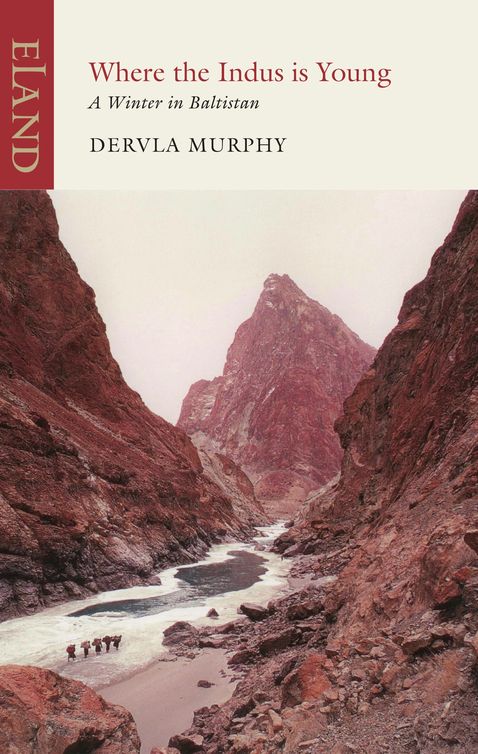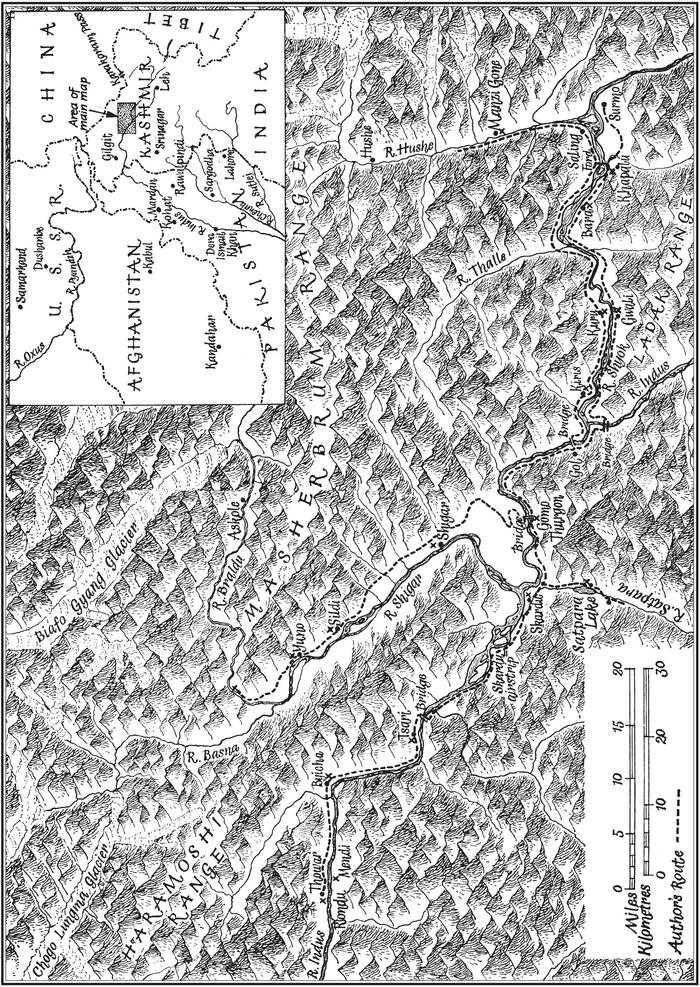Where the Indus is Young
Read Where the Indus is Young Online
Authors: Dervla Murphy


A Winter in Baltistan
DERVLA MURPHY

To Diana and Jock – most steadfast of friends, in good times and bad – with deep affection
This journey would have been impossible without the imaginative cooperation of the Pakistani authorities, who made no attempt to restrict my movements despite the present political sensitivity of their Northern Areas. It would also have been impossible without the stoicism, adaptability and sheer guts of my daughter Rachel, who never once complained, however tough the going. And it would have been far less pleasant without the friendship and practical help given so generously by the Raja of Khapalu and by Abbas Kazmi of Skardu.
For editorial help I am indebted to Jane Boulenger, Diana Murray and John Gibbons, while Alison Mills and Daphne Pearce typed heroically from a manuscript that would have been deemed totally illegible by weaker spirits.

Sketch-map showing the author’s expeditions into Baltistan
In his account of the 1913–14 Italian Expedition through the Karakorams, Giotto Dainelli sowed the seed of this book: ‘… a district – Baltistan – which all the old travellers recognise as the extreme western part of Tibet …’ At present no one has any hope of getting into Tibet proper, under acceptable conditions – and I am not sure that I would want to go there now – but the prospect of travelling through that ‘extreme western part’ was very attractive indeed. So I hastened off to the Pakistani Embassy in London, to seek further information.
During the previous fourteen months I had been having an intense relationship with India. This was based not merely on the writing of a travel-book about that country but on the making of a
concentrated
effort to achieve some degree of understanding of Hindu culture. I had spent part of the time in India and the rest of it reading, thinking, writing and feeling about India, almost to the exclusion of everything else. It had been a challenging, stimulating, exhausting, enjoyable time – and then suddenly it was over. My book was finished, and less than twenty-four hours later I entered the Pakistani Embassy.
At once, while chatting to a group of Punjabis on a dilapidated landing, I was afflicted by a mild version of what the Americans call Culture Shock. This most probably would not have affected me had there been even a week’s interval between my disengagement from India and my involvement with Pakistan. As things were, the abrupt change, on several levels, was too much.
Within the preceding weeks I had often visited India House, which gives a somewhat incongruous, not to say misleading impression of elegant affluence. The Pakistani Embassy in Lowndes Square is very different. (Or was, in November 1974.) No doubt some rooms had been kept up to embassy standards, but the many corridors, hallways and stairs traversed by me were very evidently the property of a poor
country. And the staff – in contrast to all those svelte,
impeccably-trained
Indians at India House – were so amiably clueless that they had me trotting to and fro from building to building for half an hour before I found the man I wanted. Yet that morning I was conscious of a wonderful feeling of relaxation, of at homeness – an absence of barriers.
It is perilous to venture into comparisons between India and Pakistan but sometimes one has to risk offending both sides, for the sake of readers totally unfamiliar with the subcontinent.
Most Europeans find it easier to form uncomplicated friendships with Pakistanis than with Indians; we instinctively sympathise with the underdog and Pakistan has always been the underdog vis-à-vis India. At the time of Partition India inherited a well-equipped administrative capital in good working order, while the new Karachi Government scarcely had a typewriter or a telephone to its name and was operating not from Lutyens’ stately buildings but from tin huts and cramped private houses. Moreover, those vast quantities of military stores which had been allocated to Pakistan under the Partition Agreements were being withheld by the new Government of India, and Field-Marshal Auchinleck’s HQ in Delhi was abolished before it had time to supervise their distribution. Also, most ordnance factories and army schools, apart from the famous staff college at Quetta, were in India. Yet the rougher the going became, during those early years, the more guts the Pakistanis showed, though they lacked that outside support they had somewhat naively expected. India, being far more influential, got proportionately more
consideration
from the Big Powers.
All this naturally engenders sympathy for Pakistan. Yet our ease of communication with Pakistanis probably owes most to the obvious affinities between Christianity and Islam, though nowadays this religious factor is two-edged. Theocracies are unfashionable in the West and Pakistan initially alienated many foreigners by presenting herself as an Islamic Republic. This meant not merely that all her people were Muslim (i.e., willing to say ‘There is no God but God and Mohammed is his Prophet’), but that they were fully prepared
to accept the Koran, the Sunna (traditional customs) and the Sharia. The Sharia is a formidable collection of complex laws devised by theologians more than a thousand years ago and ever since guarded against change by the
Ulema
, an even less flexible institution than the Vatican. It was plainly absurd to pretend that the majority of Pakistanis fully accepted the Sharia – individuals can be selective about these laws, while remaining good Muslims – and the 1962 Constitution dropped the description ‘Islamic Republic’. Since 1960 various steps have been taken of which the
Ulema
could not approve, notably President Ayub Khan’s ‘Muslim Family Laws Ordinance’, which restricted polygamy and divorce.
Certainly the visitor is aware of no stifling conservative theocratic presence in Pakistan, which feels considerably less religion-conscious than the officially secular Republic of India. And having fairly recently visited a number of old-established Christian institutions, in both India and Pakistan, I can vouch for it that since 1947 Christian missionaries have had a much smoother ride in Pakistan than in India. I can also vouch for the fact that even the most powerful Pakistani mullahs have far less influence than the average Irish Catholic bishop.
The leaders of India’s Muslim Revival, during the seventy years or so before Partition, were vigorously unorthodox reformers whose efforts to modernise Islam permanently antagonised the mullahs. While the idea of Pakistan was developing in the minds of some of these reformers, the mullahs opposed it almost unanimously – and not just because its advocates were unorthodox. Nationalism frustrates the Islamic ideal of a world in which all men are brothers, regardless of race, colour, class or occupation.
Baltistan covers an area of 10,000 square miles and was ruled from about 1840 by the Maharaja of Kashmir; therefore it is now part of the Disputed Territory between Pakistan and India. The UN Cease-Fire-Line forms its semicircular north-east, east and south-east border, running from the Chinese frontier almost to the Burzil Pass and making it a very ‘sensitive area’. (As one semi-inebriated Sindhi solemnly explained to me in Karachi, ‘It is the reverse of an erogenous
zone – it makes people hate not love.’) I was therefore prepared to wage a long and probably unsuccessful battle for a Balti permit. The Indians, I knew, allowed no foreigners anywhere near their Himalayan frontier and why should the Pakistanis be any more accommodating?
When I eventually found the relevant office in the embassy and made my request a cheerful gentleman behind a wide desk beamed at me and said, ‘You require no visa or permit for our Northern Areas. If you hold a valid Irish passport you may travel anywhere you like in Pakistan for as long as you like.’
‘
No permit
?’ I echoed, dazed. ‘Are you
sure
?’
‘Quite sure,’ replied the cheerful gentleman. ‘We have nothing to hide. Every traveller is welcome to every part of Pakistan. According to UN regulations you must keep ten miles away from the Cease-Fire-Line. Otherwise there are no restrictions.’ He pulled open a drawer and handed me a large glossy brochure in glorious
technicolor
. It was entitled ‘Gilgit–Hunza-Skardu’ and my heart sank. Was I too late? Had even Baltistan, of which Skardu is the capital, been dragged somehow on to the beaten tourist track? But I need not have worried. The Pakistan Tourism Development Corporation is a young organisation, as yet more given to promise than performance. Its information about Baltistan may be accurate by 1984 but was a mere Ministry of Tourism dream in 1974. Baltistan is still one of the least developed inhabited areas of Asia.
The PTDC also failed to give reliable advice about the approaches to the Northern Areas. According to their brochure, ‘A new 302-mile, all-weather road now connects Gilgit with Saidu Sharif in the Swat Valley’. On the basis of this information I planned, before leaving London, to buy a riding-pony for my daughter in Saidu and trek into Baltistan from there, turning off the new Indus Highway near the confluence of the Indus and Gilgit rivers. But in Pindi my plan was thwarted; otherwise I might not have lived to tell this tale. Towards the end of December several thousand people were killed and a forty-mile stretch of the Indus Highway was demolished by the Swat earthquake.
When we left for Pakistan Rachel was not yet six and some eyebrows were raised at my taking such a small child into the Karakorams for
the winter. But she was no amateur, even then, having spent four months in south India during the previous winter, undergoing her Asian initiation. Had that journey not been so successful, from her point of view, I would never have contemplated taking her to Baltistan. Our daily life there was obviously not going to be entirely devoid of hardship, and our style of travelling would demand a high level of endurance – by six-year-old standards – while there would be few playmates for a foreign child. But I already knew that Rachel is a natural stoic, and a muscular and vigorous little person, well able to walk ten or twelve miles a day without flagging. Moreover, as an only child she is accustomed to amusing herself for hours on end, and, though by temperament gregarious, she had then the
extraordinary
powers of adaptability common to most six-year-olds.
To me it seems that the five-to-seven-year-old stage is ideal for travelling rough with small children. Under-fives are not physically mature enough for exposure to the unavoidable health hazards, while over-sevens tend to be much less philosophical in their reactions to the inconveniences and strange customs of far-flungery. By the age of eight, children have developed their own (usually strong) views about how they wish life to be, and are no longer happy automatically to follow the parental leader. This is how it should be. I have accepted that our next joint journey – if there is one – must be something that appeals equally to Rachel and to me, rather than something imposed on Rachel by me.
On the morning of 22 November we boarded our Aeroflot plane for Karachi. Although neither of us was using our full free baggage allowance we seemed to be diabolically burdened; the essential equipment for two people who hope to survive a winter in the Karakorams cannot but seem heavy if one is obsessed about travelling light. A list of this equipment is given on page 261.
17 July 1975
